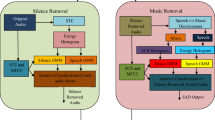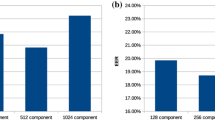Abstract
The ability of the speaker’s voice model to reproduce detailed parameterization of individual speech features is an important property for its use in solving different biometric problems. In general case one of the main reasons of performance degradation in voice biometric systems is the voice variability that occurs when speaker’s state (emotional, physiological, etc.) or channel conditions are changing. Therefore, accurate modeling of the intra-speaker voice variability leads to a more accurate voice model. This can be achieved by collecting multiple speech samples of the same speaker recorded in diverse conditions to create so-called multi-session model. We consider the case when speech data is represented by dialogues recorded in a single channel. This setup raises the problem of grouping the segments of a target speaker from the set of dialogues. We propose a clustering algorithm to solve this problem, which is based on the probabilistic linear discriminant analysis (PLDA). Our experiments demonstrate effectiveness of the proposed approach compared to solutions based on exhaustive search.
Access this chapter
Tax calculation will be finalised at checkout
Purchases are for personal use only
Similar content being viewed by others
References
Jain, A.K., Ross, A., Prabhakar, S.: An Introduction to biometric recognition. IEEE Trans. Circuits Syst. Video Technol. 14(1), 4–20 (2004)
Batchelor, J., Lee, D., Banks, D., Crosby, D., Moore, K., Kuhn, S., Rodriguez, T., Stephens, A.: Investigative Report. Florida Department of Law Enforcement (2012)
Averbouch, D., Kahn, J.: Fraud targets the contact center: What now? Speech Technology Magazine, November 2013
SESTEK, the rise of voice biometrics as a key security solution. Speech Technology Magazine (2013)
Kenny, P., Reynolds, D., Castaldo, F.: Diarization of telephone conversations using factor analysis. Sel. Top. Sign. Process. 4(6), 1059–1070 (2010)
Kenny, P.: Bayesian analysis of speaker diarization with eigenvoice priors. CRIM, Montreal, Technical report (2008)
Zheng, R., Zhang, C., Zhang, S., Xu, B.: Variational bayes based i-vector for speaker diarization of telephone conversations. In: IEEE International Conference Acoustics, Speech and Signal Processing (2014)
Kenny, P.: Joint factor analysis of speaker and session variability: Theory and algorithms. Technical report CRIM-06/08-13 (2005). http://www.crim.ca/perso/patrick.kenny
Dehak, N., Kenny, P., Dehak, R., Dumouchel, P., Ouellet, P.: Front-end factor analysis for speaker verification. IEEE Trans. Audio Speech Lang. Process. 19(4), 788–798 (2011)
Kenny, P.: Bayesian speaker verification with heavy tailed priors. In: Speaker and Language Recognition Workshop. IEEE, Odyssey (2010)
Prince, S.J., Elder, J.H.: Probabilistic linear discriminant analysis for inferences about identity. In: Proceeding of ICCV, pp. 1–8. IEEE (2007)
Zhang, S., Zhang, C., Zheng, R., Xu, B.: An investigation of summed-channel speaker recognition with multi-session enrollment. In: International Conference on Acoustics, Speech and Signal Processing (ICASSP), pp. 1640–1644 (2014)
Bishop, C.M.: Pattern Recognition and Machine Learning. Springer, New York (2006)
Kozlov, A., et al.: SVID speaker recognition system for NIST SRE 2012. In: Speech and Computer: 15th International Conference (SPECOM), pp. 278–285 (2013)
NIST SRE 2010 Evaluation Plan. http://www.itl.nist.gov/iad/mig//tests/sre/2010/NIST_SRE10_evalplan.r6.pdf
Sholokhov, A., Pekhovsky, T., Kudashev, O., Shulipa, A., Kinnunen, T.: Bayesian analysis of similarity matrices for speaker diarization. In: International Conference on Acoustics, Speech and Signal Processing (ICASSP), pp. 106–110 (2014)
Novoselov, S., Pekhovsky, T., Simonchik, K., Shulipa, A.: RBM-PLDA subsystem for the NIST i-vector challenge. In: Annual Conference of the International Speech Communication Association, pp. 378–382 (2014)
Novoselov, S., Pekhovsky, T., Shulipa, A., Kudashev, O.: Plda-based system for text-prompted password speaker verification. In: International Conference on Advance Video- and Signal-based Surveillance (AVSS), pp. 1–5 (2015)
Pekhovsky, T., Sizov, A.: Comparison of various mixtures of Gaussian PLDA-models in the problem of text-independent speaker verification. J. Instrum. Eng. 56(2), 51–61 (2013)
Acknowledgements
This work was financially supported by the Ministry of Education and Science of the Russian Federation, Contract 14.578.21.0126 (ID RFMEFI57815X0126).
Author information
Authors and Affiliations
Corresponding author
Editor information
Editors and Affiliations
Rights and permissions
Copyright information
© 2017 Springer International Publishing AG
About this paper
Cite this paper
Shulipa, A., Sholohov, A., Matveev, Y. (2017). Clustering Target Speaker on a Set of Telephone Dialogs. In: Karpov, A., Potapova, R., Mporas, I. (eds) Speech and Computer. SPECOM 2017. Lecture Notes in Computer Science(), vol 10458. Springer, Cham. https://doi.org/10.1007/978-3-319-66429-3_23
Download citation
DOI: https://doi.org/10.1007/978-3-319-66429-3_23
Published:
Publisher Name: Springer, Cham
Print ISBN: 978-3-319-66428-6
Online ISBN: 978-3-319-66429-3
eBook Packages: Computer ScienceComputer Science (R0)




